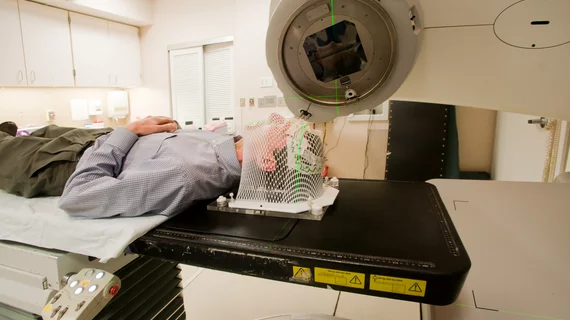Reducing patients’ stress when wearing masks for head and neck cancer screenings: 3 tips
Requiring head and neck cancer patients to wear masks during treatment can cause significant anxiety, which can also spread to radiology staffers taking part in treatment.
Despite common knowledge about the issues that bubble up from the use of thermoplastic immobilization masks, there’s been little research on how to reduce such anxiety. Wanting to close this information gap, researchers from the University of Sydney recently interviewed about 20 radiology staffers to determine best practices for treatment of head and neck cancer patients that does not induce anxiety.
One key learning from their study—published Wednesday, Nov. 20, in the Journal of Medical Imaging and Radiation Sciences—is the need for a systematic response to addressing patients’ unease.
“These perspectives suggest that to achieve changed practice concerning mask anxiety, organizations as a whole need to prioritize and incentivize holistic patient care as significantly as they do technical expertise,” wrote Natalie Klug, with the with the School of Psychology at the University of Sydney in New South Wales, Australia, and colleagues.
Head and neck cancer is an umbrella term that encompasses several different types, including nose, sinus, mouth, salivary glands and the throat. Such cancers are the sixth most prevalent across the globe, affecting about 650,000 individuals annually.
Treatment best practices call for surgery and radiation therapy, with the latter requiring a mask to stabilize patients and secure them to the treatment couch, Klug and colleagues wrote. Individuals typically wear these masks during treatment up to five times a week for upward of 40 minutes a day, lasting as long as eight weeks. Growing evidence suggests this can be a harrowing experience for cancer patients, with one study estimating that 26% experience anxiety and claustrophobia.
Klug and co-investigators wanted to better understand ways to alleviate these worries by interviewing 20 healthcare providers about their own experiences. Those included everyone from radiation oncologists and therapists to nurses and psychologists, all spread across nine Australian hospitals.
From those conversations, six themes began to emerge, which can help to inform caregivers’ future work:
- Mask anxiety is a significant problem, but can be easily missed. Interviewees believed that all patients experience some anxiety, with about 20% feeling it severely, but signs are not always obvious and some may be hesitant to share.
- Context matters, with patients already experiencing a “horrendous” disease and treatment regimen that may have them on edge.
- Trust and individual support are critical, with providers developing a relationship that allows for open communication about psychological concerns.
- Choice and control are also crucial, as providers should turn control over to patients wherever possible. This could include letting them know they can release the mask at any time, if needed.
- Psychological strategies are helpful, too. Providers should be proactive in assessing mask anxiety, and work to develop support strategies early in the treatment process.
- Culture matters for providers trying to address this issue. Health system barriers, such as time and limited resources, can hamper workers’ efforts to alleviate anxiety.
Klug and colleagues further distilled their findings into three key interventions that practices can test out to begin addressing this issue: (1) prescreen patients for mask anxiety to ensure that strategies are in place before the first encounter with the mask, and extra treatment time is allotted; (2) explore the introduction of pretreatment, psychosocial assessment clinics for head and neck cancer patients, which would facilitate the delivery of mask-related materials at a time when patients are not yet feeling overwhelmed; and (3) train staffers in psychological strategies, earmarking extra time and funding toward this endeavor.
"Future research is now needed to develop and evaluate system-wide interventions for mask anxiety, which incorporate effective implementation strategies to address these barriers,” the study concluded.

